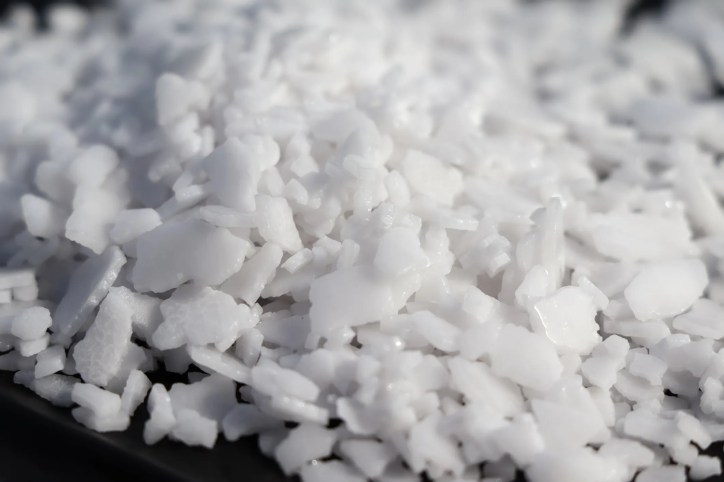Potassium hydroxide (KOH), produced electrolytically from potassium chloride (2KCl + 2H2O → 2KOH + Cl2↑ + H2↑), is water-soluble, hygroscopic, odorless, corrosive to metals, noncombustible, and very basic (with a pH of 13.5). These qualities distinguish caustic potash, as it is otherwise known, with underlying usefulness in chemical manufacturing, petroleum refining, and cleaning compounds.
In an acidic solution, as a strong alkali, potassium hydroxide adds hydroxide ions (OH–), taking up the hydrogen ions (H+) through deprotonation and, in result, regulating the pH. This benefits industrial manufacturing and processing, agriculture, as it can help with raising the pH of acidic soils, and the water industry, since it is surely ideal to secure a neutral pH for potable and other clean water supplies. For the use of potassium hydroxide, either dry or liquid, in the treatment of potable water, wastewater, and reclaimed water, American Water Works Association (AWWA) standard AWWA B511-2017 – Potassium Hydroxide offers guidance.
AWWA B511-2017 addresses an encompassing range of topics relevant to a supplier of caustic potash. Some of these focus on the KOH substance itself, including its physical and chemical requirements, as well as sampling, testing, and other verification procedures to determine the alkalinity and purity of the potassium hydroxide.
Additional subjects covered in AWWA B511-2017 are useful for suppliers after the stipulations for the potassium hydroxide have been met, and they include guidelines for packaging, shipping, and marking. This information can aid in providing transparency between the purchaser and the supplier.
The inherent physical and chemical properties and characteristics of potassium hydroxide that make it so ideal for an assortment of purposes to support the creation of products and services are unfortunately aligned with different health hazards. Just as KOH is corrosive to metals, at concentrations higher than 2 percent, it is corrosive to the human body. At concentrations lower than this, potassium hydroxide can be the culprit for a slew of irritant effects, including coughing, wheezing, conjunctivitis, tearing, and, if in the form of aerosols or mists, local effects on the respiratory tract.
For the purposes of water treatment, the dangers of contact with potassium hydroxide are succinctly emphasized no better than by the AWWA B511-2017 standard itself. When detailing the total alkalinity test, it is noted that, after dry potassium hydroxide is added to water, “a violent evolution of heat results.” To mitigate this effect, the standard advises to add the solute slowly to minimize the intensity of this effect.
The AWWA B511 standard, prepared under the direction of the AWWA Standards Committee on Softening and Conditioning Chemicals, was first released in 1991 and followed by subsequent revisions in 1996, 2000, 2005, 2010, and now 2017. AWWA B511-2017, the sixth edition of the standard, makes use of two major changes:
- Inclusion of new language in the Notice of Nonconformance section
- Inclusion of new language in the Marking section
AWWA B511-2017 – Potassium Hydroxide is available on the ANSI Webstore.
